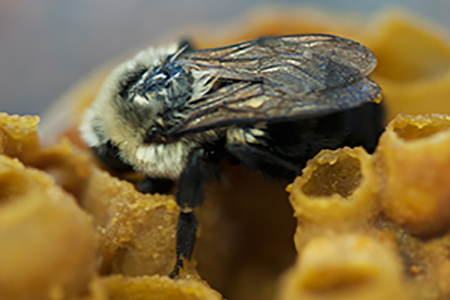
Continuing through April 12, 2015
Using sculpture, light, and sound to illustrate the methods used by bumblebees to find "A Better Nectar," Jessica Rath creates an outstanding, multi-sensory installation that is fascinating. By making the journey a "human-scaled" experience, Rath allows each viewer to travel with the bees as they go from their dark, underground nests to the bright, colorful world outside — a world alive with pulsating sound and refracted prisms of light, all communicating via properties like color that is important to a critical ecological species. Before she could embark on such an audacious project, Rath researched her subject with scientists in the Leonard Bee Lab at the University of Nevada in Las Vegas.
The highlight of the show is "Resonant Nest," designed in collaboration with Ian Schneller. In it, a human-scaled bumblebee talks, responds and communicates; backed up by music composed by Robert Hoehn. The music (performed by the CSULB Bob Cole Conservatory) is under the direction of Dr. Jonathan Talberg, all of it interspersed with weather reports, the correct time and viewer interaction.
"Bee Purple,” based on the earth’s natural light, will also stop people in their tracks. Created in collaboration with Elise Co, it is predicated on a bumblebee's unique sense of vision. Visitors follow the bees as they fly from the nest and flit from flower to flower — noting that along the way the colors they see may shift to ultraviolet and omit red entirely. However, when the flashes of rhythmic colors change from purple, yellow and aqua-green, that's a sure sign —both here visually in the artwork and in the science of bee’s sensory systems — that a source of nectar has been located. The blend of art and science here makes this fully interdisciplinary engagement compelling.
Rath's exhibit also includes a "Research Station" (an in-depth photo essay of her experience inside the Leonard Bee Lab), along with the 200-pound bass wood mold used to create the human-sized bee in "Resonant Nest." Another aspect of her extensive research resulted in a series of magnified native flowers that are viewed through microscopes provided by the campus Department of Biological Services.
As if that weren't enough, "A Better Nectar" has living examples of California wildflowers — all of them planted by elementary schools in the area under the aegis of the Long Beach Unified School District in partnership with the University Art Museum and the Payne Foundation for Wild Flowers and Native Plants. The message is loud and clear: the bees are an indispensable — and aesthetic — component of California’s ecology.
Published courtesy of ArtSceneCal ©2015
